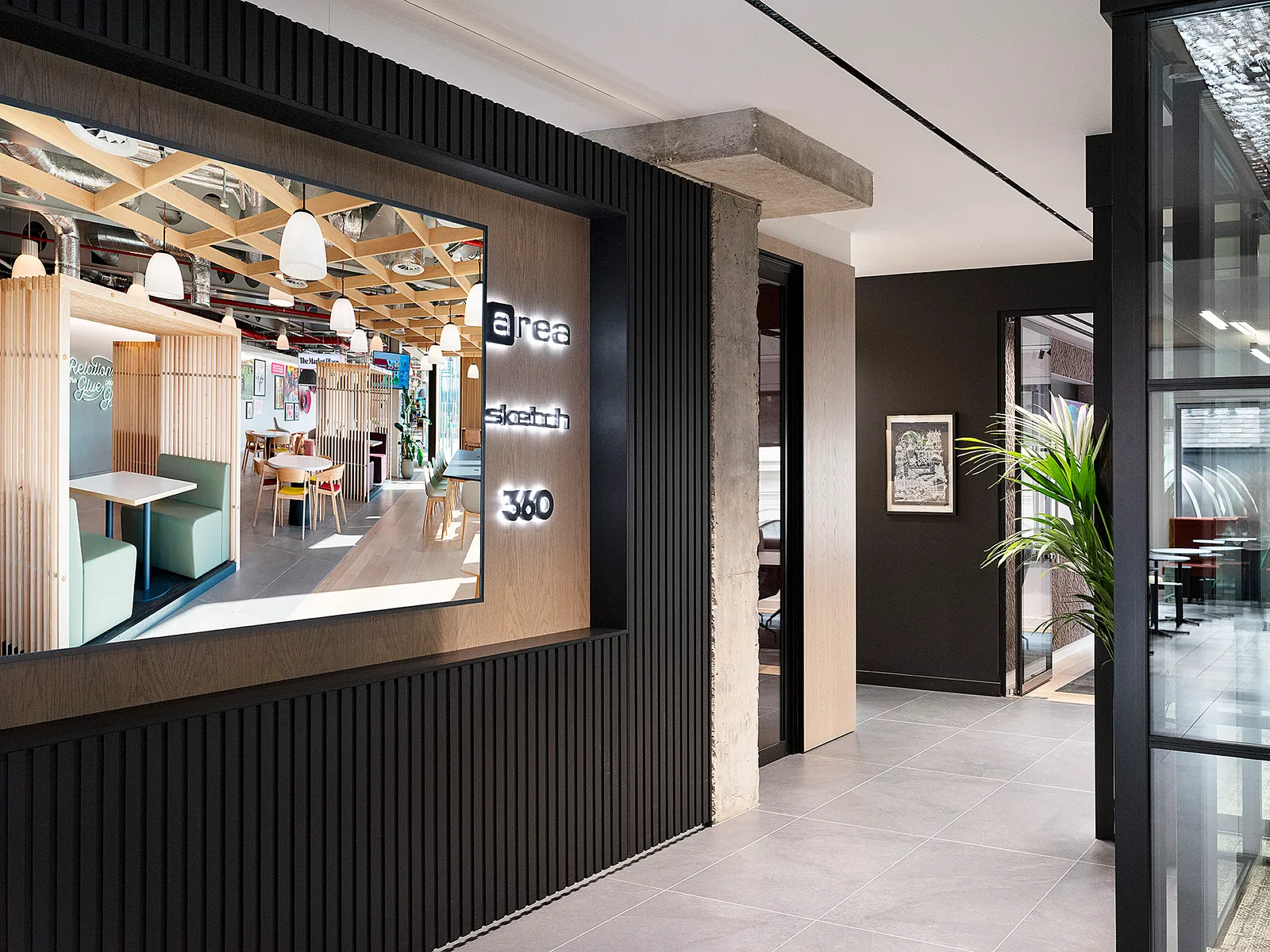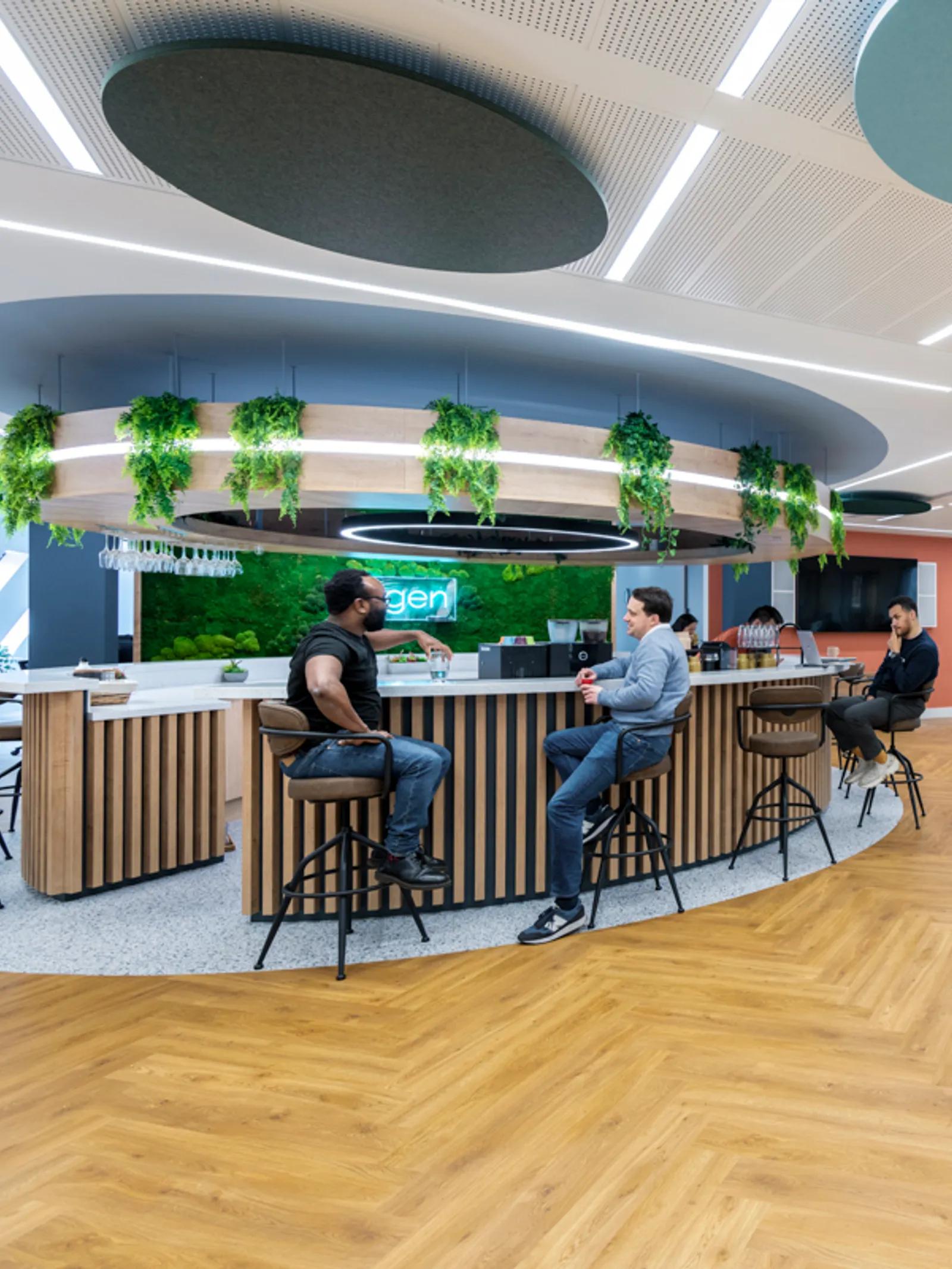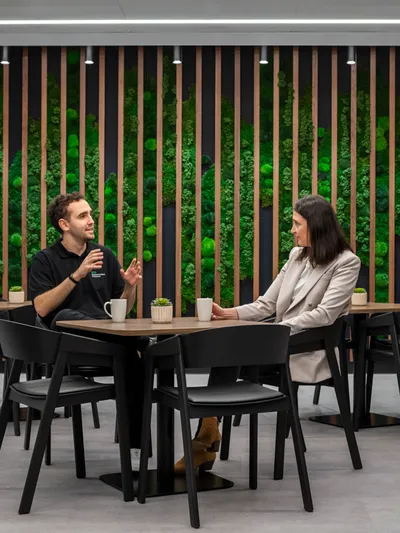2026 Office design trends
From revolutionary refits to radical redesigns, last year was an exciting year for the modern workspace. But you know what? 2026 is going to be even bigger.
From integrating innovation into every corner to future-proofing the workplace for sustainability, these are the top office design trends for 2026 and beyond.
1. Flexible working has matured: precision and purpose become paramount
Hybrid working is no longer a novelty. It’s an expectation.
According to the Office for National Statistics, roughly 28% of UK employees now work in a hybrid arrangement, while large global surveys suggest this number rises to 40–50% for knowledge-based sectors. The challenge for 2026 is not how to “allow” hybrid, but how to design for it intelligently.
In 2025, the rise of small meeting rooms for focused work and phone booths to ensure virtual meetings could be conducted with minimal disturbance became paramount. In 2026, while the need for small breakout spaces remains, the focus will shift to improvements in efficiency and calibration: ensuring every square metre is justified by measurable use.
What to expect:
Elastic capacity: Office layouts will be designed to flex weekly, desks by day, and collaboration zones by afternoon. Real-time occupancy data will feed space planning decisions, allowing Facilities teams to adapt layouts seasonally rather than annually.
Neighbourhood-based design: The traditional open plan is giving way to “activity neighbourhoods”, clusters of spaces designed for specific modes of work (deep focus, ideation, social connection, presentation).
Data-led right-sizing: Live utilisation analytics and desk sensors will help employers fine-tune their real estate footprint, saving cost while maintaining accessibility.
The message for 2026? Flexibility does simply mean incorporating modular furniture into your office designs; rather, it’s about creating a space suitable for continuous adaptation as the needs of your workforce ebb and flow.
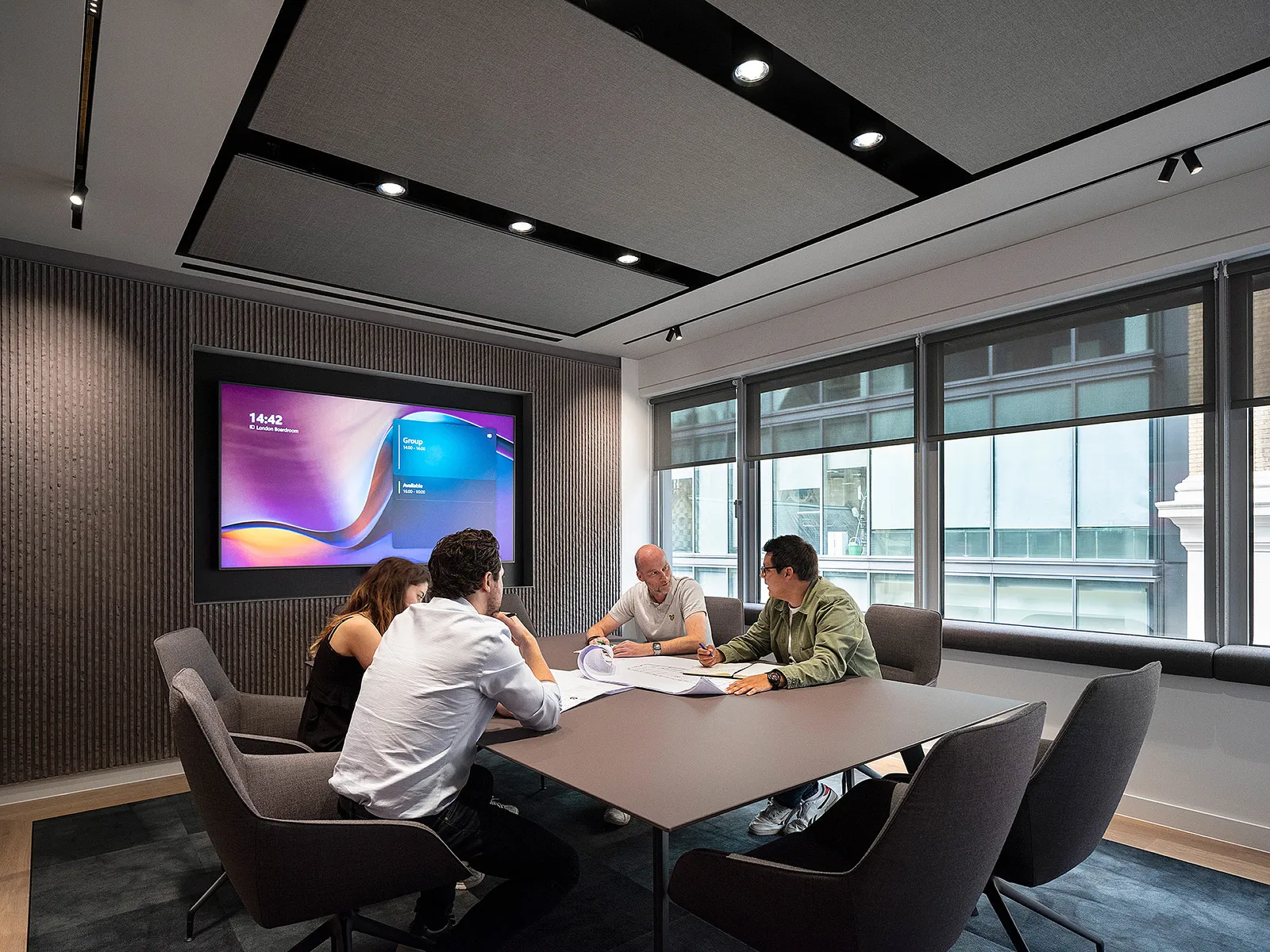
2. AI and automation quietly reshape the workplace
“AI tools will become more integrated in the way that we work – using the technology to gather data and apply evidence to the design decisions we make.” - Charlie Kent, Creative Director at Area
We can’t talk about office design trends without mentioning the technology that’s not-so-quietly touching every part of our lives. Artificial Intelligence will not redesign offices overnight, but it’s already shaping how workplaces perform.
In 2026, we’ll see more AI-driven systems integrated into building management, which could be subtle but impactful. HVAC will adjust automatically based on occupancy; lighting will balance brightness and colour temperature for specified zones; intelligent booking tools will provide a seamless, frictionless experience and enable hybrid teams to integrate more effectively.
Practical examples include:
Adaptive environments: AI algorithms will modulate temperature, airflow and lighting by activity level and daylight availability, helping to reduce energy waste and improve comfort.
Digital concierges: Intelligent assistants will schedule meetings, book rooms, or even direct employees to quieter zones during busy periods.
Predictive maintenance: Sensors will detect faults in lighting, audio-visual equipment or HVAC before users notice, minimising downtime.
The role of AI in 2026 office design will be transformative: the result will be an invisible reliability, making buildings that respond seamlessly to their occupants’ needs.

3. Community and connection return to centre stage
If the pandemic years fractured our sense of community, 2026 is the year office design rebuilds it with intent. A growing body of research, includingSteelcase’s Global Report 2024, confirms that employees are most motivated to come to the office to connect with colleagues, not for amenities or mandates.
Designing for connection now means those in charge of office design must acknowledge the contrasting needs for both openness and intimacy:
How will they achieve this?
Social “collision” points: Strategically placed coffee stations, stairwells, and casual seating areas designed to encourage spontaneous encounters.
Spaces for shared rituals: Team kitchens, hospitality lounges and project rooms that double as social venues after hours.
Inclusivity at the core: Neurodiversity-informed design, incorporating quiet zones, sensory modulation, and predictable wayfinding to ensure all employees feel comfortable and included.
A Harvard study has shown that workplaces designed to encourage “weak-tie” interactions (chance encounters between different teams) see measurable increases in innovation. Offices in 2026 will be judged by how effectively they foster those moments.
4. Nature and light as core design materials
Biophilic design is not a new concept, and yet in 2026 we can expect it to continue to mature from a visual preference to a scientifically supported performance enhancer.
The evidence is compelling:
- Harvard University’s COGfx research found that improving indoor air quality and daylight access can boost cognitive function by over 100%.
Studies show stress reduction of up to 40% from exposure to natural environments.
Employees working in spaces with daylight and greenery report higher satisfaction, better mood, and fewer sick days.
In 2026, expect this to manifest in new ways:
Daylight-first layouts: Floorplans oriented around window access, with fewer internal partitions blocking natural light.
Indoor planting ecosystems: From moss walls to micro-gardens that improve humidity and air quality.
Natural acoustics and materials: Timber, cork, and stone finishes are returning to prominence for their sensory warmth and sustainability.
Outdoor extensions: Roof terraces, courtyards, and “al fresco” meeting zones are becoming standard inclusions in high-performance buildings.
These aren’t aesthetic gestures; they’re productivity strategies. Nature will remain the most cost-effective wellbeing investment available to employers.

5. Sustainability moves from aspiration to measurement
“Circularity is now a common requirement in commercial design and build fit-outs, driven by client demand for more sustainable practices. Projects increasingly include material reuse, lifecycle thinking, and closed-loop strategies as standard specification requirements." - Duncan Morris, Head of Sustainability at Area
While sustainability is rooted in how a business conducts its operations from a moral perspective, the landscape now points towards sustainability becoming a commercial no-brainer, and one that businesses must consider in order to remain competitive.
What’s changing:
Circular economy principles: Refurbishment, reuse and repair will outpace new-build as the default sustainable route. Designers are now required to demonstrate end-of-life strategies for materials.
Low-carbon interiors: Expect continued growth in carbon-negative materials such as bamboo, recycled steel, hemp-based insulation and reclaimed timber.
Transparent supply chains: Fit-out companies will increasingly publish embodied carbon calculations for every project.
Energy-smart operations: Integration of solar shading, responsive ventilation and heat recovery will become standard features of compliant workplaces.
Sustainability in 2026 won’t be a design feature; it will be an operational requirement, one that touches procurement, planning and performance.
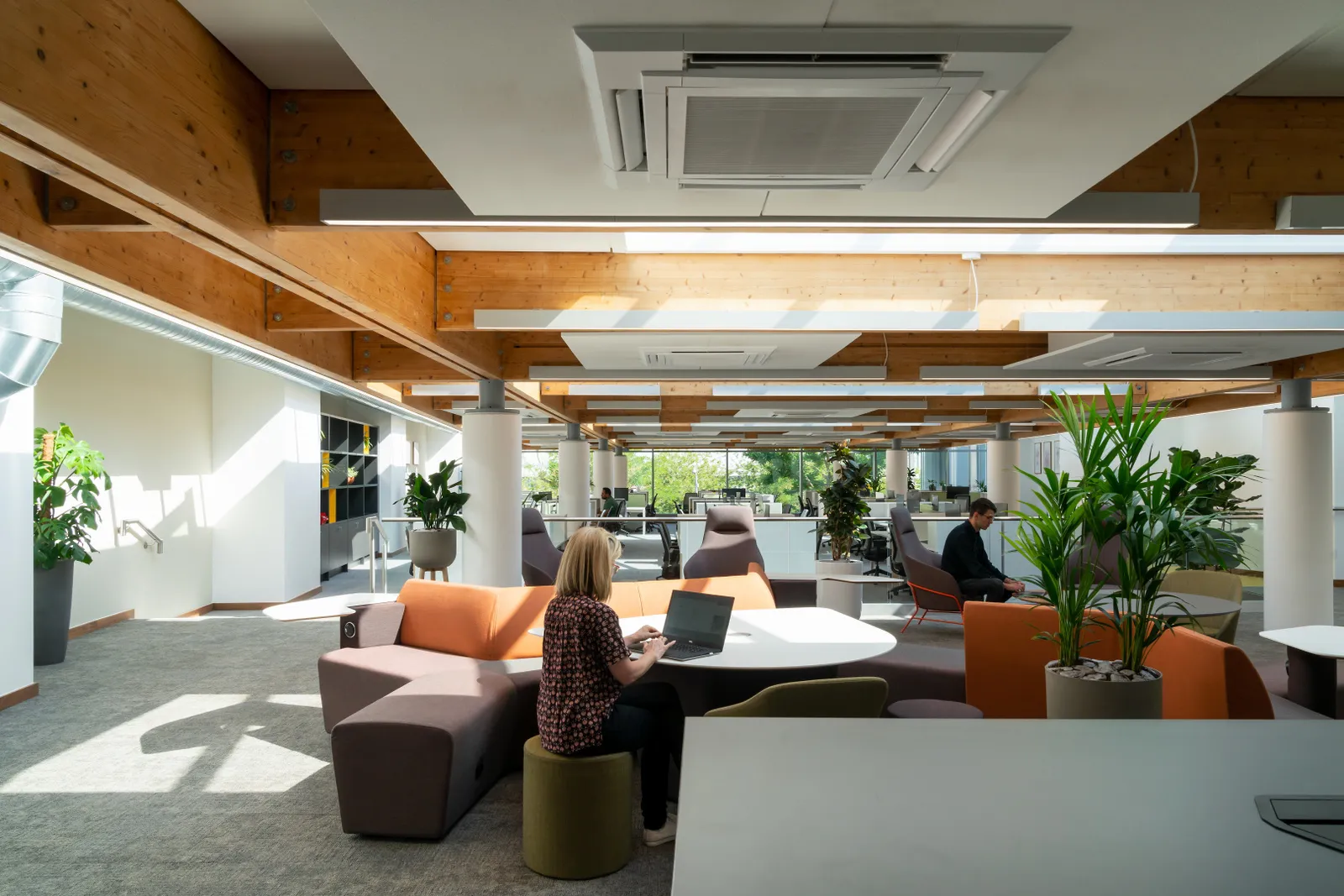
6. HR-led design: culture, belonging and wellbeing
The most successful office redesigns will now involve consulting with HR teams to ensure that workplaces are created not only with employee wellbeing front and centre, but to serve as a cultural amplifier — an architectural expression of organisational values.
According to Gallup’s 2025 State of the Workplace report, employees who feel a sense of belonging show:
56% higher job performance
50% lower turnover risk
75% fewer sick days
Designers are responding by crafting offices that feel personal, authentic and inclusive:
Spaces that tell stories: Using art, finishes and layout to reflect company values, heritage and diversity.
Variety of choice: From quiet focus pods to communal lounges, giving people autonomy over how they work.
Ergonomic integrity: Adjustable sit-stand desks, chairs that promote movement, and layouts that encourage mobility.
Wellness ecosystems: Integrating rest spaces, mental health rooms and quiet retreat areas.
In 2026, the most successful workplaces will be those that are emotionally intelligent, not just operationally efficient.
7. The rise of the multi-sensory workspace
After years of focusing on visuals, designers are now embracing sound, scent, and touch as key elements of workplace wellbeing.
What to expect:
Acoustic zoning: Soundscaping that matches work modes, calm ambient noise for focus, livelier atmospheres for collaboration.
Scent and air quality: Subtle aromatherapy and filtered airflow systems enhancing cognitive clarity.
Tactile surfaces: Textures chosen to reduce sensory fatigue, such as wool, felt, timber and other natural materials over synthetic gloss.
Human-centric lighting: Circadian-tuned systems adjusting colour temperature throughout the day to align with biological rhythms.
These details may appear subtle, but when executed all together can create workplace environments that impress clients, retain employees and enhance concentration, productivity and comfort for longer periods.
8. The office as a curated experience
By 2026, the office will act less as a default workplace and more as a destination for creativity and community. With modern businesses recognising the importance of creativity and human connection more than ever before, the focus will be on drawing people in, leaving room for creative expression, and to do that, the environment itself must deliver an experience worth the commute.
Expect to see:
Hospitality crossovers: In-house cafés, lounges and event spaces borrowing cues from boutique hotels.
Art and narrative: Rotating exhibitions, curated playlists and materials that shift through the day.
Immersive technology: Interactive displays, AR collaboration tools and “digital twins” of workspaces used for simulation and feedback.
In short, the workplace becomes a theatre. Not in the performative sense, but as a space where culture and collaboration are staged deliberately.

9. Technology integration becomes invisible
The best technology is the kind you don’t notice.
Offices in 2026 will see technology woven quietly into architecture: microphones in ceilings, cameras in light fittings, wireless power, adaptive screens and automated booking.
Key innovations:
AI-assisted meetings: Systems that transcribe, summarise and share actions instantly.
Smart acoustics: Audio systems that isolate voices automatically for clearer hybrid calls.
Touchless interaction: Gesture control and voice commands replacing switches and remotes.
It’s not about filling rooms with gadgets, but removing friction from everyday interactions, and ensuring technology supports human connection rather than competes with it.
10. Measuring experience: the rise of workplace performance analytics
In 2026, a new metric, one that’s focused on human outcomes will become integrated in forward-thinking offices. Data on energy usage and occupancy rates will still be reported on, but alongside this we’ll see workplace analytics shift focus towards the metrics that truly matter and reports will include numbers on aspects such as collaboration frequency, and employee satisfaction and wellbeing.
Insights that arise from combining sensor data with HR feedback, will enable companies to link space performance to business performance. The result? Design becomes a living experiment — one that adapts, evolves and proves its value.
Final Thoughts
The workplace in 2026 won’t evolve around a single design principle; it will be driven by integration. Technology and craftsmanship will combine, sustainability and comfort will interlink, and flexibility and belonging will go hand in hand.
Offices will continue to blur the boundaries between home, hospitality, and lab, becoming ecosystems that support every facet of working life.
Ultimately, successful office design in 2026 will hinge on one question:
Does this environment make people feel better, work smarter, and connect more deeply?
If the answer is yes, then it’s not just on trend, it’s future-ready.
If you want to design your office for the future, get in touch with the expert team at Area to see how we can help.
